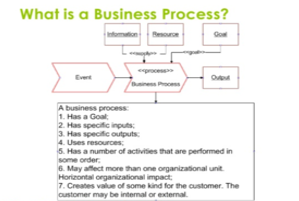Business Process
What is a Business Process?
A business process is a collection of linked tasks that find their end in the delivery of a service or product to a client. A business process has also been defined as a set of activities and tasks that, once completed, will accomplish an organizational goal. The process must involve clearly defined inputs and a single output. These inputs are made up of all of the factors which contribute (either directly or indirectly) to the added value of a service or product. These factors can be categorized into management processes, operational processes, and supporting processes. The definition of the term business process and the development of this definition since its conception by Adam Smith in 1776 has led to such areas of study as Operations Development, Operations Management, and to the development of various Business Management Systems.[1]

source: Dr. Jackie Damrau, BPMN
Types of Business Process
There are three types of business processes:
- Management processes, the processes that govern the operation of a system. Typical management processes include "corporate governance" and "strategic management".
- Operational processes, processes that constitute the core business and create the primary value stream. For example, taking orders from customers, and opening an account in a bank branch.
- Supporting processes, which support the core processes. Examples include Health & Safety, accounting, recruitment, call center, and technical support.
A business process begins with a mission objective and ends with the achievement of the business objective. Process-oriented organizations break down the barriers of structural departments and try to avoid functional silos. A complex business process may be decomposed into several sub-processes, which have their own attributes but also contribute to achieving the goal of the super-process. The analysis of business processes typically includes the mapping of processes and sub-processes down to the activity/task level. Business processes are designed to add value for the customer and should not include unnecessary activities. The outcome of a well-designed business process is increased effectiveness (value for the customer) and increased efficiency (less use of resources). Business Processes can be modeled through a large number of methods and techniques. For instance, the Business Process Modeling Notation is a Business Process Modeling technique that can be used for drawing business processes in a workflow.[2]
See Also
Business Process refers to structured activities or tasks that produce a specific service or product for a particular customer or customer. It's a crucial aspect of organizational operations, focusing on efficiency, effectiveness, and flexibility in responding to varying customer demands.
- Process Mapping: A visual representation of the actions or steps to complete a particular task or service. It's used for understanding and analyzing how a process works, identifying areas of improvement.
- Workflow Automation: The design, execution, and automation of processes based on workflow rules where human tasks, data, or files are routed between people or systems based on pre-defined business rules. This enhances efficiency and reduces the potential for error.
- Business Process Management (BPM): A systematic approach to making an organization's workflow more effective, efficient, and capable of adapting to an ever-changing environment. BPM aims to improve processes continuously.
- Lean Management: A methodology derived from manufacturing (specifically the Toyota Production System) that focuses on minimizing waste within business processes, thereby maximizing value to the customer.
- Six Sigma: A disciplined, data-driven approach for eliminating defects in any process – from manufacturing to transactional and from product to service. It combines quality management and business process improvement.
- Total Quality Management (TQM): A management approach to long-term success through customer satisfaction, focusing on continuous improvement of processes, products, and services.
- Business Process Reengineering (BPR): The fundamental rethinking and radical redesign of business processes to achieve dramatic improvements in critical, contemporary measures of performance, such as cost, quality, service, and speed.
- Operational Excellence (OpEx): The execution of the business strategy more consistently and reliably than the competition, emphasizing the management of workflows and processes as key to achieving sustainable improvement.
- Process Optimization: The discipline of adjusting a process to optimize some parameters without violating some constraints. The most common goals are minimizing cost and maximizing throughput and/or efficiency.
- Change Management: The approach to transitioning individuals, teams, and organizations to a desired future state. In business processes, it refers to the methods and manners in which a company describes and implements change within its internal and external processes.
These terms collectively represent the breadth of strategies, techniques, and tools available for analyzing, designing, implementing, and improving business processes. They underscore the importance of continually assessing and refining processes to meet evolving business goals and customer needs efficiently and effectively.
- Business Process Architecture
- Business Process Engineering (BPE)
- Business Process as a Service (BPaaS)
- Business Process Analysis
- Business Process Analytics
- Business Process Automation
- Business Process Change Cycle
- Business Process Discovery
- Business Process Engine (BPE)
- Business Process Execution Language (BPEL)
- Business Process Framework (eTOM)
- Business Process Improvement (BPI)
- Business Process Integration
- Business Process Mapping
- Business Process Management (BPM)
- Business Process Maturity Model (BPMM)
- Business Process Model
- Business Process Modeling
- Business Process Modeling Language (BPML)
- Business Process Modeling Notation (BPMN)
- Business Process Offshoring (BPO)
- Business Process Orchestration
- Business Process Outsourcing (BPO)
- Business Process Query Language (BPQL)
- Business Process Reengineering (BPR)
- Business Process Simulation
- Business Process Specification Schema (BPSS)
- Business Process Standardization
References
Further Reading
- Business Processes and Business Systems Sourcemaking
- How to Analyze a Business Process Bridging the Gap
